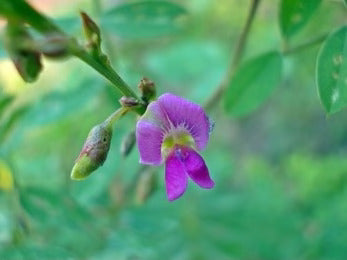The perennial erect herb known as sharpunkha (Tephrosia purpurea) can grow up to 50 cm tall. The stem is cylindrical, woody, 0.5–1.5 cm thick, and slightly angular near the apex. Its exterior surface is glabrous and green. The leaves are mucronate, stipules 3-6 mm long, lanceolate, base cuneate, apex obtuse to emarginate or truncate, leaflets are 7–15, 1-2.8 x 0.3-1 cm, oblanceolate to obovate. Pedicels are 3–4 mm long, bracts are 2 mm long, and flowers are around 7 mm long. They are leaf-opposed pseudoracemes. The calyx is pubescent, 3–4 mm long, and has subulate lobes. Corolla: orbicular, pink to purplish. The staminal tube length is 4 mm. Pods are linear-oblong, 2.5–4 x 0.3–0.4 cm, and contain 5–7 seeds. Dark brown, ellipsoid seeds are produced.
General Information
In Ayurveda, sharpunkha is very important medicinally. This well-known Ayurvedic herb is used to treat splenomegaly and liver cirrhosis. This herb is highly advantageous for preserving the body's normal hemoglobin levels. Sharpunkha is regarded as a beneficial plant for liver health in Ayurveda. In addition, the plant helps treat digestive ailments and is beneficial to the digestive system. This plant is beneficial for respiratory issues and cough. This plant also has strong anti-hyperlipidemic and anti-diabetic effects. This herb contains a variety of photochemical substances, including lupeol, rutin, palmitic acid, palmitoleic acid, palmitic acid, tepurindiol, linoleic acid, oleic acid, vitex, threonine, lysine, isoleucine, karanjin, phenylalanine, tephrone, and linoleic acid. These phytochemical substances are all brimming with incredible abilities to address a wide range of health problems.
Classification
- Kingdom - Plantae
- Sub kingdom - Tracheobionta
- Super division - Spermatophyta
- Division - Magnoliophyta
- Class - Magnoliopsida
- Subclass - Rosidae
- Order - Fabales
- Family - Fabaceae
- Sub family - Papilonaceae
- Genus - Tephrosia
- Species - Purpurea
Habitat
It is a typical wasteland weed that grows. It is grown as a crop for green manure in various places.
Other Names
- Latin Name - Tephrosia purpurea
- Sanskrit name - Shimbiphala, Mahaushadhi, Sharapunkha, Pleehashatru, Neelavrukshakruti.
- Hindi name - Saraponkh
- English name - Wild indigo or Purple tephrosia
- Telugu name - Vempali Chettu
- Marathi name - Unhali
- Kannada name - Egyali
- Malayalam name - Katamiri
- Tamil name - Kolingi
Ayurvedic Properties
|
|
Hindi / Sanskrit |
English |
|
Rasa (Taste) |
Tikta, Kashaya |
Bitter, Astringent |
|
Guna (Physical Property) |
Laghu, Rooksha, Teekshna |
Light, Dry, Piercing |
|
Virya (Potency) |
Ushna |
Hot |
|
Vipaka (Post-Digestive Taste) |
Katu |
Pungent |
Effects On Doshas
It balances the vata and kapha doshas.
Practical Uses
- It is well known that using this plant to treat liver cirrhosis works well. It supports both the liver's detoxification and the production of new liver cells. Additionally, the herb relieves symptoms such as bleeding from the nose, weight loss, decreased appetite, jaundice (yellow coloring), anorexia, itchy skin, weakness, ascites (swelling of the abdomen), and edema (swelling of the legs). It is therefore a useful herb in the treatment of liver diseases.
- This herb works well for managing splenomegaly. It aids in the generation of red blood cells. This herb also treats the symptoms of splenomegaly, such as anemia, exhaustion, easy bleeding, stomach fullness, and upper abdominal pain.
- This herb has many qualities that preserve the kidneys. It supports the kidney system's strength and facilitates the body's elimination of waste.
- The herb is very helpful in the management of skin conditions. The herb's insecticidal qualities are used to treat skin eruptions. This herb's leaves contain rotenoid, a pesticide. On the other hand, seeds have a flavonoid called lanceolarin B that promotes skin healing. Therefore, using this plant to cure a variety of skin conditions like eczema, scabies, leprosy, etc., is highly effective.
- This herb's anti-diabetic qualities aid in preserving normal blood sugar levels. Additionally, this herb aids in the management of diabetes symptoms, including increased urination, exhaustion, weight loss, excessive thirst, hazy vision, and sluggish wound healing.
- This herb's analgesic and antipyretic qualities are particularly effective in treating fever.
- Additionally, this herb has strong anti-inflammatory qualities that aid in the relief of body aches.
- Herbs with antimicrobial properties are very helpful in treating a variety of bacterial, fungal, and viral ailments.
- It is well recognized that this plant is helpful in treating problems related to female reproductive health. PCOS (Polycystic Ovarian Syndrome), ovarian cysts, and uterine fibroids can all be effectively treated with this plant. This herb aids in shrinking uterine cyst size and any protrusions.
- This herb's anticancer qualities aid in the treatment of cancer. Without having any negative effects on health, this herb naturally promotes the formation of healthy cells while inhibiting the growth of cancerous ones.
- This herb works really well for treating stomach issues. It aids in relieving acidity, heartburn, intestinal pain, and indigestion, among other symptoms.
Parts Used
- Roots
- Whole plant
Dosage
3-6 gram powder and 10-20 ml juice.

